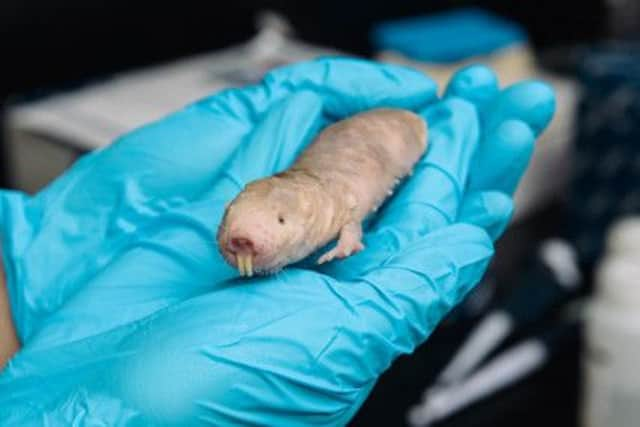Rodent’s cell tissue could be cancer breakthrough


The naked mole rat, a hairless rodent that lives in ant-like colonies underground, appears to enjoy complete protection against the disease, despite its unusually long 30-year lifespan.
Now for the first time scientists believe they know why. The discovery could lead to exciting new cancer treatments for human patients.
Advertisement
Hide AdAdvertisement
Hide AdThe key to the mole rat’s freedom from cancer is a gooey substance in its body tissue that stops normal cells turning cancerous.
Known as “high molecular weight hyaluronan”, or HMW-HA, it surrounds mole rat cells and in the laboratory clogged up vacuum pumps and tubing.
When the “goo” was taken away, cells became vulnerable to cancer triggers and started forming tumours.
In the mole rat, HMW-HA’s primary function is generating a very flexible, elastic skin that allows it to squeeze through narrow underground tunnels.
Its rejuvenating effect on skin is already well known to the cosmetics industry, which uses it in anti-wrinkle creams and injections. This suggests HMW-HA could safely be used to treat cancer.
Lead scientist Dr Andrei Seluanov, from the University of Rochester, US, said: “There’s indirect evidence that HMW-HA would work in people. It’s used in anti-wrinkle injections and to relieve pain from arthritis in knee joints, without any adverse effects.
“Our hope is that it can also induce an anti-cancer response.”
The naked mole rat’s unique form of hyaluronan – part of the connective material between cells, or extracellular matrix – is absent from cell cultures from other mammals, including humans, mice and guinea pigs.
Advertisement
Hide AdAdvertisement
Hide AdIt has giant molecules, more than five times larger than those of mouse or human hyaluronan. The research, published in the journal Nature, showed that mole rat hyaluronan activates a powerful anti-cancer gene called p16 which prevents cells proliferating when too many of them crowd together.
Next the scientists plan to test the anti-cancer effectiveness of HMW-HA on mice, after which they will focus on human cells.
“A lot of cancer research focuses on animals that are prone to cancer,” said co-author Dr Vera Gorbunova, also from the University of Rochester. “We think it’s possible to learn strategies for preventing tumours by studying animals that are cancer-proof.”
The naked mole rat is the only mammal known that lives like a social insect, in colonies dominated by an oversized “queen” which mates with one or two males. The rest of the colony is made up of smaller tunnel-digging workers and soldiers.
Another peculiar feature of the creature is that despite being a mammal, it is essentially cold-blooded and lacks the ability to maintain a steady body temperature.